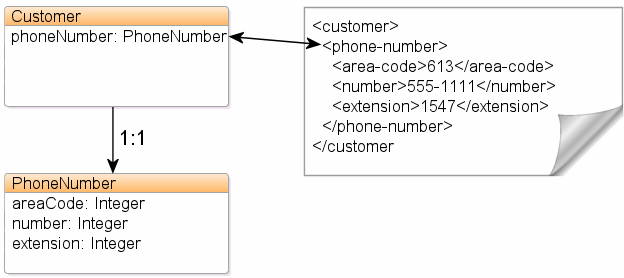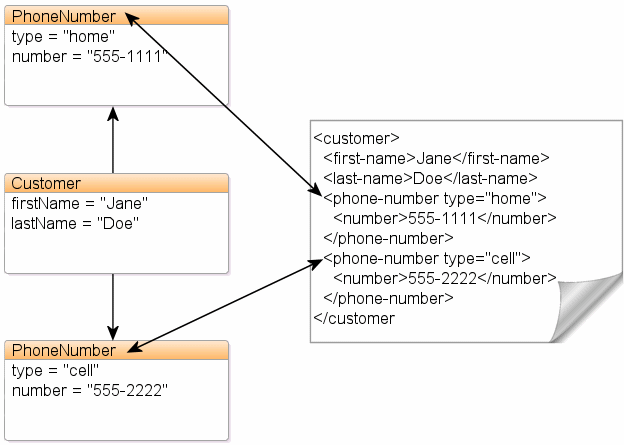6 Privately Owned Relationships
This chapter includes the following sections:
6.1 Mapping Privately Owned One-to-One Relationships
This section demonstrates several ways to map a one-to-one relationship between objects. By default, one-to-one relationships are privately-owned in JAXB – their XML content will appear nested inside the owning element. For example, a Customer with a one-to-one mapping to a PhoneNumber would be marshalled as:
Example 6-1 Sample XML Mapping
<customer>
<name>Bob Smith</name>
<id>1982812</id>
<phone-number>
<area-code>613</area-code>
<number>5550210</number>
<extension>20016</extension>
</phone-number>
</customer>
6.1.1 Mapping to an Element
Given the XML schema in Example 6-2, Figure 6-1 illustrates a one-to-one (1:1) relationship between two complex types.
<?xml version="1.0" encoding="UTF-8"?>
<xsd:schema xmlns:xsd="http://www.w3.org/2001/XMLSchema">
<xsd:element name="customer" type="customer-type"/>
<xsd:complexType name="customer-type">
<xsd:element name="phone-number" type="phone-type"/>
</xsd:complexType>
<xsd:complexType name="phone-type">
<xsd:element name="area-code" type="xsd:int"/>
<xsd:element name="number" type="xsd:int"/>
<xsd:element name="extension" type="xsd:int"/>
</xsd:complexType>
</xsd:schema>
Example 6-3 shows how to annotate your Java class to obtain this mapping with EclipseLink. The standard JAXB @XmlElement annotation can be used to indicate that the associated Java field should be mapped to an XML element.
Note:
By default, JAXB will assume all fields on your Java object are@XmlElements, so in many cases the annotation itself is not required. If, however, you want to customize the Java field's XML name, you can specify an @XmlElement annotation with a name argument.Example 6-3 Using the @XmlElement Annotation
package example;
import javax.xml.bind.annotation.*;
@XmlRootElement
@XmlAccessorType(XmlAccessType.FIELD)
public class Customer {
@XmlElement(name="phone-number")
private PhoneNumber phoneNumber;
...
}
package example;
import javax.xml.bind.annotation.*;
@XmlAccessorType(XmlAccessType.FIELD)
public class PhoneNumber {
@XmlElement(name="area-code")
private Integer areaCode;
private Integer number;
private Integer extension;
...
}
Example 6-4 shows how to define your mapping information in an EclipseLink's XML Bindings document.
Example 6-4 Sample XML Mapping
...
<java-type name="Customer">
<xml-root-element name="customer"/>
<java-attributes>
<xml-element java-attribute="phoneNumber" name="phone-number" type="PhoneNumber"/>
</java-attributes>
</java-type>
<java-type name="PhoneNumber">
<java-attributes>
<xml-value java-attribute="areaCode" name="area-code" type="java.lang.Integer"/>
<xml-value java-attribute="number" type="java.lang.Integer"/>
<xml-value java-attribute="extension" type="java.lang.Integer"/>
</java-attributes>
</java-type>
...
6.1.2 Using EclipseLink's @XmlPath Annotation
By default, your Java attributes will be mapped to XML based on their attributes Java name, or by a name specified in an @XmlElement annotation. This mapping is based on XPath, and EclipseLink's @XmlPath annotation allows you to customize this mapping. For example, you can use it to control the nesting of your elements in XML:
Example 6-5 Using the @XmlPath Annotation
package example;
import javax.xml.bind.annotation.*;
import org.eclipse.persistence.oxm.annotations.*;
@XmlRootElement
@XmlAccessorType(XmlAccessType.FIELD)
public class Customer {
@XmlPath("contact-info/phone-number")
private PhoneNumber phoneNumber;
...
}
Example 6-6 Using EclipseLink XML Bindings
...
<java-type name="Customer">
<xml-root-element name="customer"/>
<java-attributes>
<xml-element java-attribute="phoneNumber" name="phone-number"
type="PhoneNumber" xml-path="contact-info/phone-number"/>
</java-attributes>
</java-type>
...
This will produce the following XML:
<customer>
<contact-info>
<phone-number>
<number>555-631-2124</number>
</phone-number>
</contact-info>
</customer>
You can also use @XmlPath to map to different occurrences of the same element in XML, by index. For example:
Example 6-7 Using the @XmlPath Annotation
package example;
import javax.xml.bind.annotation.*;
import org.eclipse.persistence.oxm.annotations.*;
@XmlRootElement
@XmlAccessorType(XmlAccessType.FIELD)
public class Customer {
@XmlPath("contact-info/phone[1]")
private PhoneNumber homePhone;
@XmlPath("contact-info/phone[2]")
private PhoneNumber workPhone;
...
}
will produce the following XML:
<customer>
<contact-info>
<phone>
<number>555-631-2124</number>
</phone>
<phone>
<number>555-631-8298</number>
</phone>
</contact-info>
</customer>
For information on using XPath in your mappings, see "Mapping Using XPath Predicates".
6.2 Mapping Privately Owned One-to-Many Relationships
This section illustrates how to map one-to-many relationships with EclipseLink.
The schema in Example 6-8 a typical one-to-many (1:M) relationship between Customer and PhoneNumber, as shown in Figure 6-2.
Example 6-8 Sample XML Mapping
<?xml version="1.0" encoding="UTF-8"?>
<xsd:schema xmlns:xsd="http://www.w3.org/2001/XMLSchema">
<xsd:element name="customer" type="customer-type"/>
<xsd:complexType name="customer-type">
<xsd:sequence>
<xsd:element name="first-name" type="xsd:string"/>
<xsd:element name="last-name" type="xsd:string"/>
<xsd:element name="phone-number" type="phone-type" minOccurs="0" maxOccurs="unbounded"/>
</xsd:sequence>
</xsd:complexType>
<xsd:complexType name="phone-type">
<xsd:sequence>
<xsd:attribute name="type" type="xsd:string"/>
<xsd:element name="number" type="xsd:int"/>
</xsd:sequence>
</xsd:complexType>
</xsd:schema>
6.2.1 Mapping to Elements
Example 6-9 shows how to annotate your Java class to obtain this mapping with EclipseLink. The standard JAXB @XmlElement annotation, when used on a Collection or array field, can achieve this.
Example 6-9 Using the @XmlElement Annotation
package example;
import javax.xml.bind.annotation.*;
@XmlRootElement
@XmlAccessorType(XmlAccessType.FIELD)
public class Customer {
@XmlElement(name="first-name")
private String firstName;
@XmlElement(name="last-name")
private String lastName;
@XmlElement(name="phone-number")
private List<PhoneNumber> phoneNumbers;
...
}
package example;
import javax.xml.bind.annotation.*;
import org.eclipse.persistence.oxm.annotations.*;
@XmlAccessorType(XmlAccessType.FIELD)
public class PhoneNumber {
@XmlAttribute
private String type;
private Integer number;
...
}
Example 6-10 shows how to define your mapping information in EclipseLink's OXM metadata format.
Example 6-10 Sample XML Mapping
...
<java-type name="Customer">
<xml-root-element name="customer"/>
<java-attributes>
<xml-element java-attribute="firstName" name="first-name" type="java.lang.String"/>
<xml-element java-attribute="lastName" name="last-name" type="java.lang.String"/>
<xml-element java-attribute="phoneNumbers" name="phone-number" type="PhoneNumber" container-type="java.util.ArrayList"/>
</java-attributes>
</java-type>
<java-type name="PhoneNumber">
<java-attributes>
<xml-attribute java-attribute="type" type="java.lang.String"/>
<xml-value java-attribute="number" type="java.lang.Integer"/>
</java-attributes>
</java-type>
...
6.2.2 Grouping Elements using the @XmlElementWrapper Annotation
To make the elements of the Collection appear inside a grouping element, you can use @XmlElementWrapper:
Example 6-11 Using the @XmlElementWrapper Annotation
package example;
import javax.xml.bind.annotation.*;
@XmlRootElement
@XmlAccessorType(XmlAccessType.FIELD)
public class Customer {
@XmlElement(name = "phone-number")
@XmlElementWrapper(name="phone-numbers")
private List<PhoneNumber> phoneNumbers;
...
}
This will produce the following XML:
<customer>
<first-name>Bob</first-name>
<last-name>Smith</last-name>
<phone-numbers>
<phone-number type="Home">
<number>5559827222</number>
</phone-number>
<phone-number type="Work">
<number>5558872216</number>
</phone-number>
</phone-numbers>
</customer>

